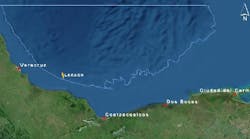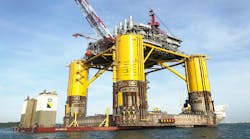Mike Paulin
Duane DeGeer
Glenn Lanan
INTECSEA, Inc.
The first Arctic & Cold Regions poster was produced in February 2011, to summarize and condense the growing body of Arctic offshore field development technical knowledge generated around the world. The poster, developed by INTECSEA and published byOffshore, was a success, allowing the Arctic engineering community to quickly access and reference key Arctic engineering data, field development strategies, and technical solutions. A revised poster was subsequently issued in December 2012, with the addition of several elements, including a technical development roadmap and produced hydrocarbon transport options.
INTECSEA's Arctic poster has once again been updated in this month's edition of Offshore magazine. It is important to note that numerous individuals and organizations have provided input to update the survey of offshore Arctic technology challenges and solutions. The individuals and organizations who have contributed to the success of this year's poster can be found in the acknowledgements section on the poster.
The Arctic has long been considered a prospective region for field development and hydrocarbon production due to the large estimated volumes of oil and gas in place. The poster references US Geological Survey data, which states that the Arctic is estimated to contain over 400 Bboe. This represents roughly one quarter of the world's undiscovered, yet recoverable, oil and gas. Production companies are willing to invest in a variety of Arctic offshore drilling, engineering, construction, and operation solutions in order to advance Arctic production opportunities.
Recognizing the potential reserves in the Arctic, it is also well known that environmental conditions and field development requirements vary greatly within the Arctic and for other cold regions. The poster attempts to provide a balanced overview of the major technical challenges and available solutions. In addition to the estimated hydrocarbon reserves in place, it presents a summary of current geographical sea ice coverage limits, existing Arctic production facilities, field development strategies, concept selection alternatives, export solutions, and future challenges for Arctic and cold regions production.
The increasing number of offshore Arctic fields being safely and economically produced demonstrates that technical solutions are available to develop these valuable hydrocarbon reserves. In the last few years, notableArctic field development advancements include: the set-down of the Prirazlomnoye gravity-based structure in anticipation of production in the Pechora Sea; continued drilling campaigns in the Barents Sea, Baffin Bay, and the Chukchi and Beaufort seas (shallow hole drilling only); seismic acquisition in the Kara, Barents, Laptev, and Chukchi seas, and preliminary engineering for numerous prospects in the North American Arctic, the Barents Sea, and the Grand Banks of Newfoundland, Canada.
In addition, improvements in material behavior, acceptance of progressive design philosophies, and implementation of reliable operational strategies are enabling offshore Arctic prospects to be developed.
Technology advancements
The Centre for Arctic Resource Development (CARD) brings together industry, academic, and technology partners to conduct medium- to long-term R&D focused on improving Canada's capacity and capability to support safe, responsible, cost-effective, and sustainable hydrocarbon development in Arctic and other ice prone regions. CARD's recently completed Arctic Development Roadmap identified, organized, and prioritized key R&D topics for advancing required knowledge, technology, methodology, and training. A high level overview of the Roadmap has again been included in this year's Arctic poster.
A number of JIPs are addressing the technological advancements needed to safely, efficiently, and economically proceed with hydrocarbon exploration and development in the Arctic.
A JIP for the Development of a Trenching System for Subsea Pipelines, Flowlines and Umbilicals in Ice Scour Environments aims to develop a full-scale, commercially ready pipeline burial/trenching system. The results of the multi-phased project will allow future field developments to be planned based upon a reliable, predictable trenching solution capable of excavating and backfilling relatively deep trenches in a variety of soil conditions and water depths, while operating in harsh marine conditions.
A JIP for Arctic Oil Spill Response Technology has also been initiated that will concentrate on minimizing the risk of offshore spills where sea ice is present. Oil spill response technology will be developed and tested for application in the Arctic where, depending on the season, sea ice, darkness, and extreme temperatures can affect operations.
An ongoing JIP intends to study the magnitude of, and the parameters that affect, subgouge displacements for the design of buried submarine pipelines in cold regions (Phase 1, completed). Phase 1A will be comprised of production of model soil and laboratory soil testing, soil placement trials, model keel pull evaluation, evaluation of pore water pressure development, and numerical modeling to evaluate physical boundary conditions. Final engineering design will include structural design of the test basin and enclosure, final design of the test keels, refined cost estimates to establish the facility, and project risk assessment.
Finally, a recently kicked-off JIP on subsea pipeline leak detection has the interest of many, as fiber optic cable (FOC) systems are being considered as a potentially reliable means of detecting small, chronic leaks on pipelines operating in the Arctic offshore. Despite current FOC use for othersubsea applications, no comprehensive testing has been reported in the public domain to date regarding FOC subsea applications in the Arctic and other cold regions. This project intends to close this gap. With improved ability to detect and identify leaks, an operator can make better operational decisions.
Future developments
Arctic offshore design, subsea equipment technology, operating strategies, and our understanding of Arctic environmental conditions will continue to advance and, as a result, the options available for Arctic and cold regions field development will grow. Other Arctic development concepts are becoming feasible, such as subsea tiebacks, all-electric subsea control technology, full subsea separation and water reinjection, seafloor chemical storage and injection, and gas reinjection advancements have made possible the concept of full subsea (no-host) completions in the Arctic.




